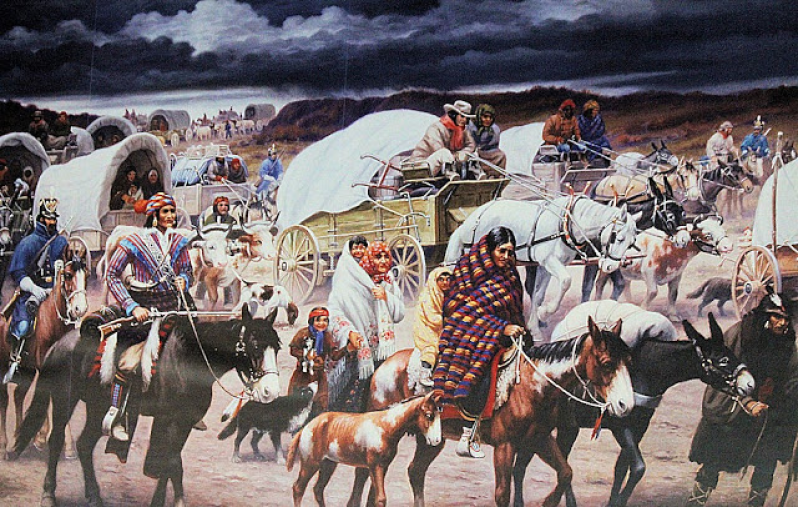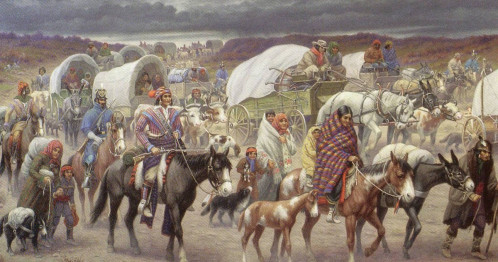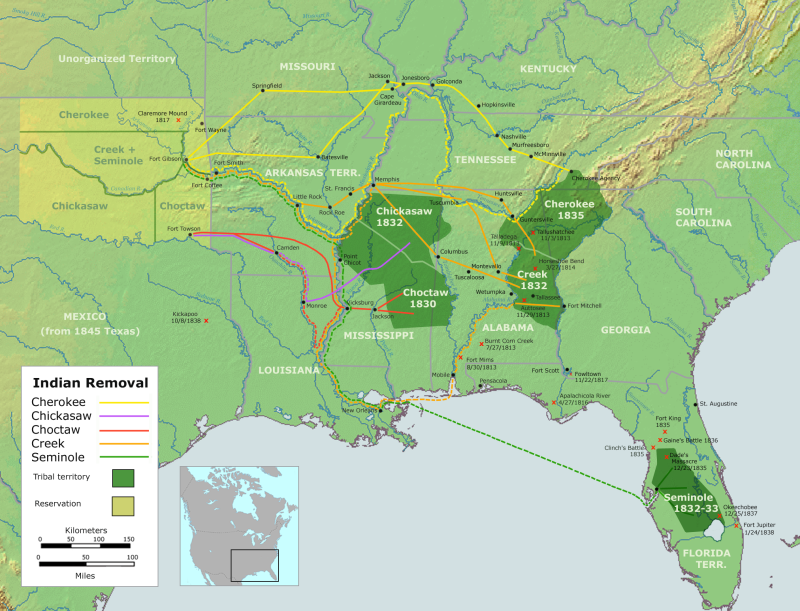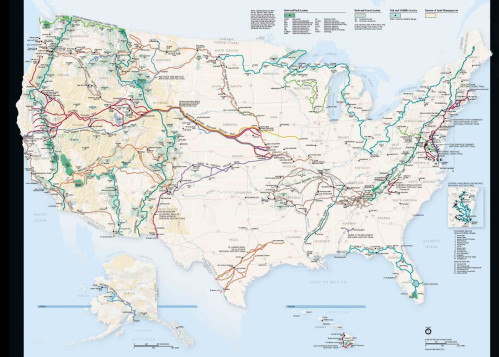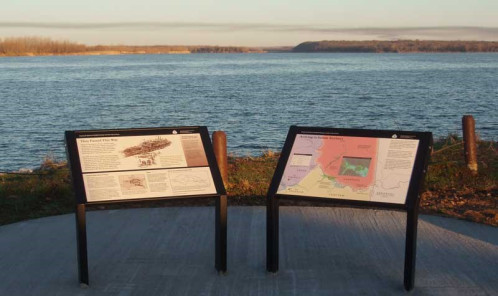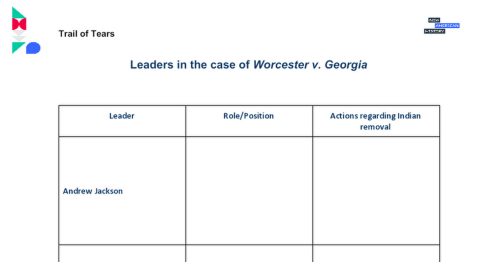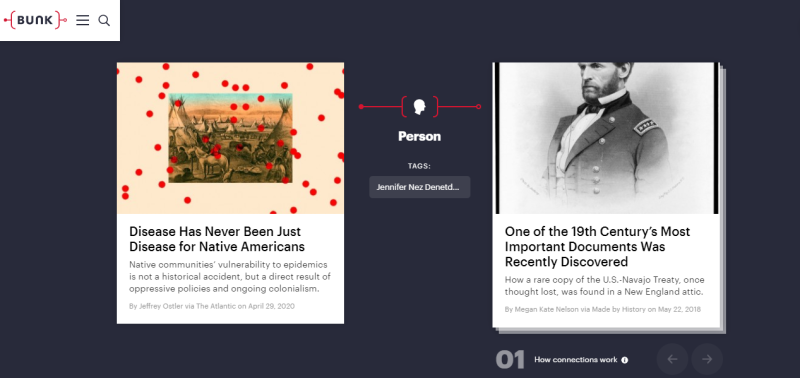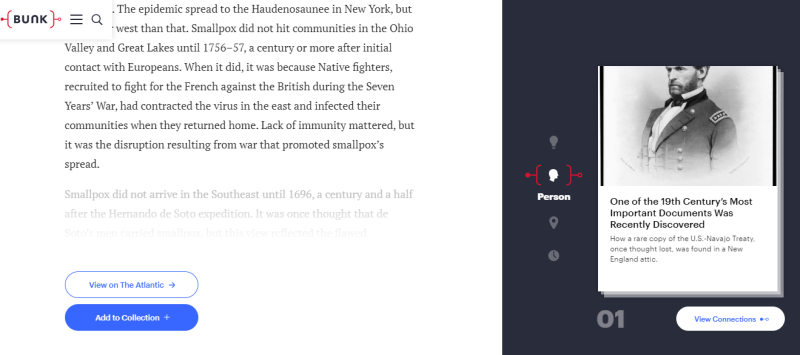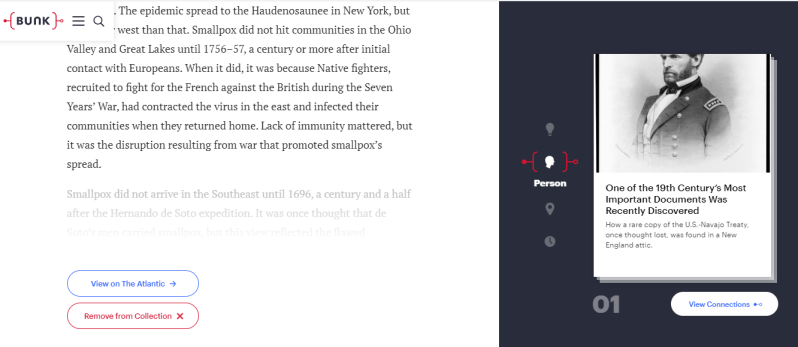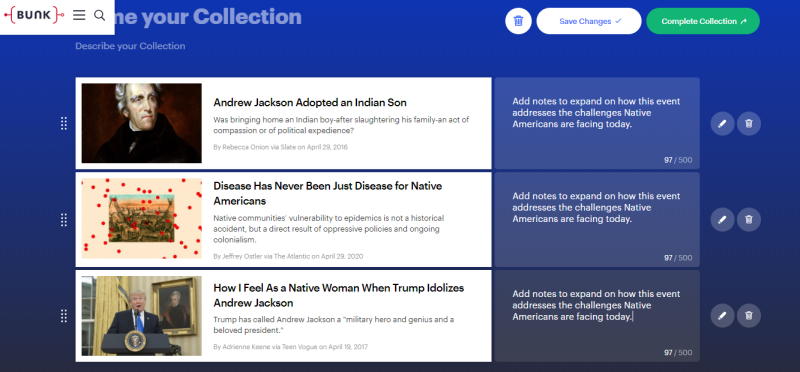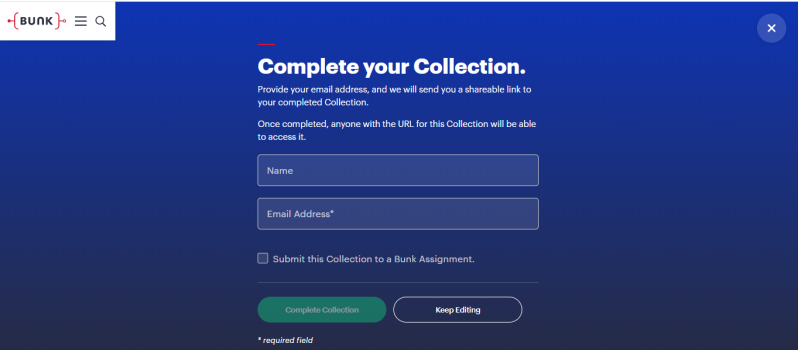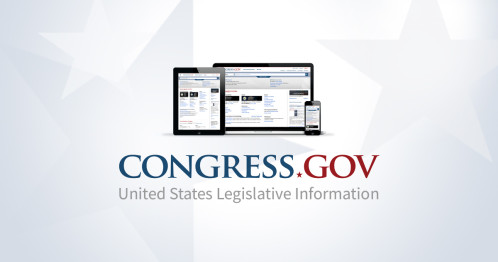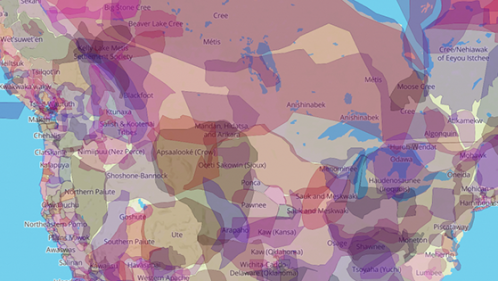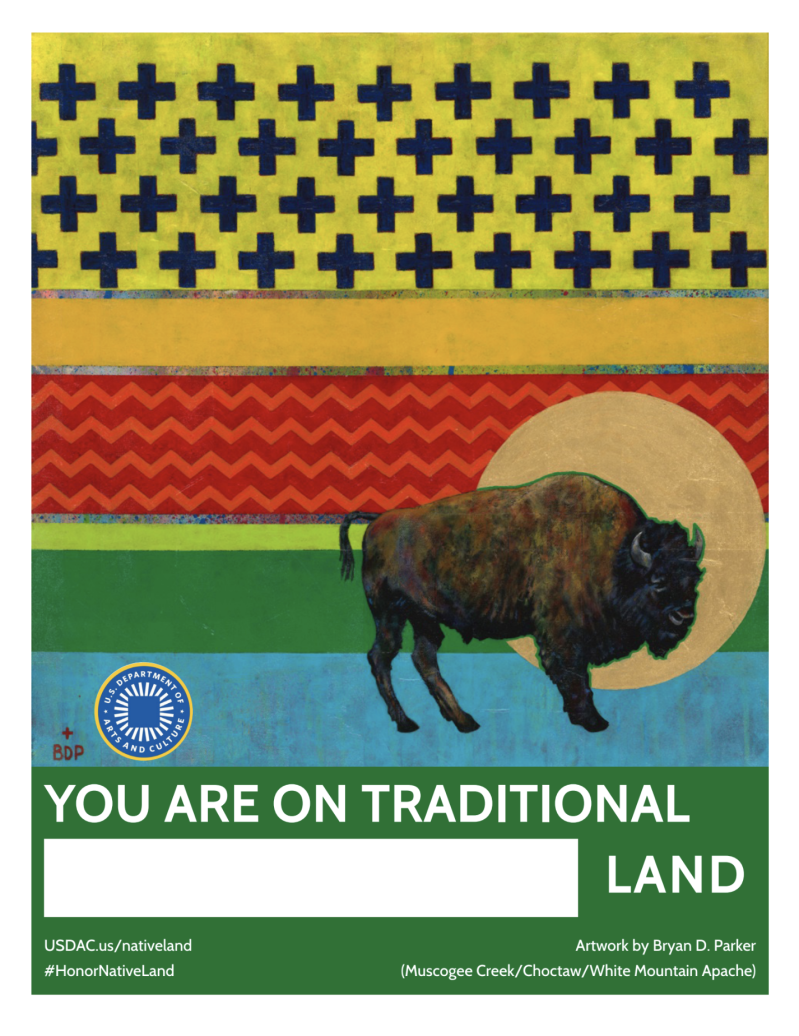This work by New American History is licensed under a Attribution-NonCommercial-ShareAlike 4.0 (CC BY-NC-SA 4.0) International License. Permissions beyond the scope of this license may be available at newamericanhistory.org.
Teaching Beyond the "Trail of Tears"
View Student Version
Standards
C3 Framework:D2.His.3.9-12. Use questions generated about individuals and groups to assess how the significance of their actions changes over time and is shaped by the historical context.D2.Civ5.9-12. Evaluate citizens’ and institutions’ effectiveness in addressing social and political problems at the local, state, tribal, national, and/or international level.D2.Civ.12.9-12. Analyze how people use and challenge local, state, national, and international laws to address a variety of public issues. D2.Civ.13.9-12. Evaluate public policies in terms of intended and unintended outcomes and related consequences.
National Council for Social Studies:Theme: Time, Continuity, ChangeTheme: People, Places, and EnvironmentsTheme: Individuals, Groups, and InstitutionsTheme: Power, Authority, and GovernanceTheme: Civic Ideals and Practices
National Geography Standards: Standard 1 - How to use maps and other geographic representations, tools, and technologies to acquire, process, and report information from a spatial perspective
Teacher Tip: Think about what students should be able to KNOW, UNDERSTAND, and DO at the conclusion of this learning experience. A brief exit pass or other formative assessment may be used to assess student understandings. Setting specific learning targets for the appropriate grade level and content area will increase student success.
Suggested Grade Levels: High School (9-12)
Suggested Timeframe: 2 class sessions, 30-45 minute class periods
Suggested Materials: Internet access via laptop, tablet or mobile device; projector and screen for viewing video segments as a whole group if providing face to face instruction.
Key Vocabulary
Annex - forcibly adding new land to a state or nation
Assimilate - for a person or group of people to become similar to others in habits or culture
Atrocities - violent, cruel acts
Barbarity - cruelty, inhumane treatment
Blasphemous - being disrespectful to religion or God
Covenant - An agreement in a deed to real estate (land/property) that restricts future use of the property, often enforceable against future owners. Restrictive covenants based on race were declared unconstitutional in 1949Inferior - a lower political or social status of a group of people
Missionary - someone who promotes his religion to others in an effort to recruit new followers
Plunder - to steal valuables from others
Reconciliation - restoring positive relations between groups or individuals
Sovereign - government authority over others
Vociferations - speaking out in protest
Read for Understanding
Teacher Tips:
This Learning Resource includes language in the body of the text to help adapt to a variety of educational settings, including remote learning environments, face-to-face instruction, and blended learning.
If students are working remotely, you may consider providing opportunities for them to collaborate with a partner or small group of classmates using video conferencing, access to an online chat feature, or breakout rooms. Digital tools such as Google Docs or Google Slides may also be used for collaboration. Rewordify helps make a complex text more accessible for those reading at a lower Lexile level while still providing a greater depth of knowledge.
In this Learning Resource, students will use the Think Pair Share and S-I-T teaching strategies and explore connections to build a collection in Bunk. For more information about Connections, Assignments, or Collections in Bunk, visit bunkhistory.org.
These Learning Resources follow a variation of the 5Es instructional model, and each section may be taught as a separate learning experience, or as part of a sequence of learning experiences. We provide each of our Learning Resources in multiple formats, including web-based and an editable Google Doc for educators to teach and adapt selected learning experiences as they best suit the needs of your students and local curriculum. You may also wish to embed or remix them into a playlist for students working remotely or independently.
For Students:
This lesson explores the forced removal of Native Americans from their ancestral lands in the southeast United States in the 1830's-1850's. It was developed as many schools were closed during the COVID-19 global pandemic. Suggested tips for teachers and students engaging in remote learning are included, and some learning strategies and directions have been modified to assist schools with both face to face and virtual instruction.
Engage:
How did the Indian Removal Act impact Native Americans?
Between 1830 and 1850, over 60,000 Native Americans were forcibly removed from their ancestral homelands in the southeast region of the United States, under President Andrew Jackson’s Indian Removal Act of 1830. These included members of the Chickasaw, Choctaw, Creek, Seminole, and Cherokee peoples, as well as other mixed-race people and enslaved Africans who previously lived among these nations.
Forced to march over a thousand miles, several thousand died and many were buried in unmarked graves along the route often referred to as “The Trail of Tears.” Those who survived were displaced and escorted by state or local militias into government-designated Indian Territory in present-day Oklahoma.
Take a few minutes to study this painting, The Trail of Tears, by artist Robert Lindneux, depicting their Journey of Injustice.
Select one person from the painting to analyze by completing the following:
- List five details about this person.
- What is the mood of this painting? What feeling does it give you?
- What do you think is happening?
To learn more about the Trail of Tears, read this excerpt on Bunk:
After reading the excerpt, turn and talk to a partner, or if working remotely, use the chat box or other collaboration strategy recommended by your teacher to Think - Pair - Share three examples of unfair treatment experienced by the Cherokees as explained by a missionary who witnessed Indian removal. You may choose to continue reading the complete article by selecting the “View on...” button.
Your teacher may ask you to record your answers on an exit ticket.
Explore:
Why were the Cherokee and other Native Americans removed from their lands in the 1830s?
Watch this brief video on the PBS LearningMedia site to learn more about President Andrew Jackson’s use of the Indian Removal Act.
While watching the video, complete the following S-I-T prompts:
- One Surprising fact or idea
- One Interesting fact or idea
- One Troubling fact or idea
Afterwards, turn and talk with your partner sharing some of your reflections. If working remotely, your teacher may provide opportunities to collaborate with classmates using video conferencing, access to an online chat feature, or breakout rooms.
Next, examine the routes taken by different Native American tribes as part of the Indian Removal Act.
To recognize the events of this journey, the National Park Service has established a National Historic Trail along the routes of the Trail of Tears. Go to the NPS website to discover more information about National Historic Trails.
Next, investigate the interactive map that follows the Trail of Tears routes. Click on locations that are near you or in which you are interested. Notice the variety of historically significant places you can visit including historic homes, museums, and visitor centers.
You can also see various exhibits, photos, and videos if you want to learn even more about the Trail of Tears.
Your teacher may ask you to record your answers on an exit ticket.
Explain:
What steps did leaders take to resolve the arguments over Native Americans’ lands?
Some Native American tribes, like the Seminole tribe of Florida, physically resisted removal from their lands. Others fought using legal means. In the case of Cherokee Nation v. Georgia (1831), the Cherokee tribe asserted that Georgia laws passed to take their lands were a violation of previous land treaties. The Supreme Court dismissed the case, noting that the Cherokee Nation was not a foreign nation within the U.S. boundaries, and thus the federal government had no right to interfere in the actions of the state of Georgia.
However, one year later, the Supreme Court ruled very differently when a Christian minister named Samuel Worcester sued the state of Georgia challenging that it did not have a right to regulate activities on the Cherokee lands.
Learn more by reading the brief article about the court case Worcester v. Georgia (1832) and complete the chart explaining the role of each leader regarding Indian removal. The information about Samuel Worcester has been completed for you.
Read the following quotes made by key leaders in the conflict over Native American lands:
“To save him from this alternative, or perhaps utter annihilation, the General Government kindly offers him a new home, and proposes to pay the whole expense of his removal and settlement."
“The Indian nations had always been considered as distinct, independent political communities retaining their original natural rights as the undisputed possessors of the soil.”
“We are denationalized; we are disfranchised. We are deprived of membership in the human family! We have neither land nor home, nor resting place that can be called our own.”
Select your favorite quote listed above and use this link to create a SketchQuote. Sketchnotes are a form of visual note taking that allows you to combine hand lettering and sketches to annotate a variety of content, including quotes. You can also use information from your chart to add to your SketchQuote.
Your teacher may ask you to share your SketchQuote on a digital platform or record your answers on an exit ticket.
Elaborate:
What challenges are Native American tribes facing today?
Using the Bunk website, investigate the modern issues facing Native American tribes by searching “Native Americans” and clicking on one of the articles that interests you.
Notice the related content to the right of the excerpt. The stack of cards contains other articles, maps or content somehow connected to the original article on the left of the screen.
The connection icons located to the left of the cards here represent Idea, Person, Place and Time, which refers to a connected article from a different time period. These icons and the connected articles you see on the screen may change over time as new content is added to Bunk.
Select the “View Connections” button.
Notice how the screen changes.
Take some time to explore this and other connections to the original excerpt you chose. Notice how each of the connections icons (Idea, Place, Person, Time) leads you to a new stack of cards with different articles and topics. Each of these topics in turn has a list of “tags” below the icon to help guide you towards new and different content.
Now that you know how Bunk Connections work, you will be building a Collection* of articles to help you answer the question, What challenges are Native American tribes facing today?
To build a Collection, click on the first article that you have chosen and scroll down to the bottom of the excerpt to locate the Add to Collection button.
You will see a box labeled “Add a note.” This is where you will annotate, or write a brief description of how this excerpt helps you answer the question. Be sure to save your note using the green Save Note button. If you decide you want to remove an excerpt from your Collection, you can return to the excerpt and select the red “Remove from Collection button.
Continue adding 3-5 excerpts to your collection, exploring the connections on Bunk and annotating each one. Be sure you are saving as you go along. Once you are finished, you may locate the blue bar at the bottom of your screen and select finalize. You MUST save and finish this during one class period.
You will need to give your collection a title, and add your name and teacher’s name/class period. You may reorder the excerpts, and edit or delete a note or excerpt until you are satisfied with your work. Be sure you SAVE CHANGES before you select the green Complete Collection button.
You will need to use an email address to share or retrieve your collection. For safety reasons, your teacher may choose to have you use their school email address, or they may use the Assignment feature instead of Collections on Bunk.
Keep checking back on Bunk for more content. New content is added every day!
*(Note: Your teacher may prefer you to complete an Assignment they created in Bunk if your school does not allow students to access email. This is similar to the Collections feature in Bunk).
Your teacher may ask you to record your answers on an exit ticket.
Extend:
How has the modern United States government addressed past and current issues facing Native Americans?
In recent years, the United States government has begun acknowledging past transgressions against Indigenous populations in our country. Read this excerpt of the Senate Joint Resolution 14 from the 111th Congress (2009).
Answer the following questions:
- Which three provisions do you think are the most significant?
- Does the apology go far enough? Why or why not?
- What additional steps should the US government take in its relationship with Native American tribes?
In an effort to make all Americans more aware of historic Native American territories, the U.S. Department of Arts and Culture is calling “on all individuals and organizations to open public events and gatherings with acknowledgment of the traditional Native inhabitants of the land.” If you would like to join this action, you can read more about it on the USDAC site.
Not all Indigenous peoples are in agreement with the practice of using a Land Acknowledgement. This Bunk excerpt explores the topic in more depth. Before adding a Land Acknowledgement to the agenda for a public event, a public-facing document, or as part of a learning experience for students, use the Native-land.ca map territories map to access and contact the local nations in your area and open a dialogue on the topic.
Next, determine which Native American tribes lived in your area by using this map.
Finally, you can share this information by creating a graphic design that you can share in your school, community, or via social media. This poster is one example created by others that is displayed on the USDAC site.
Your teacher may ask you to share your poster or record your answers on an exit ticket.
Citations:
Brownback, Sam. “Text - S.J.Res.14 - 111th Congress (2009-2010): A Joint Resolution to Acknowledge a Long History of Official Depredations and Ill-Conceived Policies by the Federal Government Regarding Indian Tribes and Offer an Apology to All Native Peoples on Behalf of the United States.” Congress.gov, August 6, 2009. https://www.congress.gov/bill/111th-congress/senate-joint-resolution/14/text.
“Cherokee Nation v. Georgia.” Federal Judicial Center. Accessed July 24, 2020. https://www.fjc.gov/history/timeline/cherokee-nation-v-georgia.
Garrison, Tim Alan. “Worcester v. Georgia (1832).” New Georgia Encyclopedia. New Georgia Encyclopedia, February 20, 2018. https://www.georgiaencyclopedia.org/articles/government-politics/worcester-v-georgia-1832.
“Honor Native Land: A Guide and Call to Acknowledgement.” U.S. Department of Arts and Culture. Accessed August 1, 2020. https://usdac.us/nativeland.
Jones, Evan, and Matthew Dessem. “‘Work of Barbarity’: An Eyewitness Account of the Trail of Tears.” Bunk History. Slate, February 10, 2019. https://www.bunkhistory.org/resources/3885.
Lindneux, Robert. “Trail of Tears.” Painting, 1942. http://robertlindneux.com/art/lindneux-at-woolarco/.
Native American Removal from the Southeast. National Geographic. National Geographic . Accessed July 24, 2020. https://www.nationalgeographic.org/thisday/may28/indian-removal-act/.
Native Land. Native Land Digital. Accessed August 1, 2020. https://native-land.ca/.
Parker, Bryan D. You Are on Traditional Land. Honor Native Land. U.S. Department of Arts and Culture, October 1, 2017. https://encrypted-tbn0.gstatic.com/images?q=tbn%3AANd9GcQH6z0rb-sxULDqJhvblfa0hg6A80aHYS80fA&usqp=CAU.
Pillar, Wendy, and Heather Marshall. “NAH Sketchquotes.” Google Docs. Google, June 24, 2020. https://docs.google.com/document/d/1OpRRe9eK-xyb9UOY-AtEMCFjAtC7bQSuiAQcVAyXKcc/edit.
“Places To Go Trail of Tears Interactive Map.” National Parks Service. U.S. Department of the Interior, November 18, 2019. https://www.nps.gov/trte/planyourvisit/places-to-go.htm.
President Jackson's Message to Congress "On Indian Removal." December 6, 1830. Records of the United States Senate, 1789‐1990. Record Group 46. Records of the United States Senate, 1789‐1990. National Archives and Records Administration. https://www.nps.gov/museum/tmc/MANZ/handouts/Andrew_Jackson_Annual_Message.pdf
Ross, John. “Letter from Chief John Ross ‘To the Senate and House of Representatives September 28, 1836.” PBS. Public Broadcasting Service. Accessed July 15, 2020. https://www.pbs.org/wgbh/aia/part4/4h3083t.html.
“Samuel A. Worcester, Plaintiff in ERROR v. THE STATE OF GEORGIA.” Legal Information Institute. Legal Information Institute. Accessed July 15, 2020. https://www.law.cornell.edu/supremecourt/text/31/515.
Sobo, E., Lambert, M., & Lambert, V. (2021, October 7). Land acknowledgments meant to honor indigenous people too often do the opposite. Bunk History. Retrieved from https://www.bunkhistory.org/resources/8864.
Trail of Tears. PBS LearningMedia. American Experience, 2020. https://vpm.pbslearningmedia.org/resource/akh10.socst.ush.exp.trail/trail-of-tears/.
“Trail of Tears Photos & Multimedia.” National Parks Service. U.S. Department of the Interior, November 22, 2019. https://www.nps.gov/trte/learn/photosmultimedia/index.htm.
View this Learning Resource as a Google Doc


